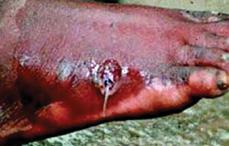Dracunculiasis
John S. Schieffelin and Richard A. Oberhelman
 EPIDEMIOLOGY
EPIDEMIOLOGY
Dracunculiasis (dracontiasis, guinea worm disease) is caused by infection of subcutaneous and connective tissues with the guinea worm Dracunculus medinensis. Humans are the only known reservoir. Once a scourge affecting thousands of people around the world, the range of this organism has been greatly reduced as a result of a global eradication program spearheaded by the Carter Center’s Global 2000 program. After an estimated 3.5 million cases in 1986, 25,217 cases were reported in 2006.1Over 180 countries have now been certified as free of guinea worm by the World Health Organization. Currently, the Carter Center and the Centers for Disease Control and Prevention (CDC) estimate that the incidence of guinea worm infection fell by 95% between 1986 and 1996 such that it is now estimated that there are fewer than 10,000 cases, which are limited to five African countries—Sudan, Ghana, Nigeria, Niger, and Mali. Sudan alone accounts for more than two thirds of the total cases reported worldwide. Virtually all cases occur in rural, isolated areas. The economic impact of infection is significant, with adults losing about 100 days of work and children missing 25% of school when symptomatic.2,3
 PATHOPHYSIOLOGY
PATHOPHYSIOLOGY
When an individual drinks water contaminated with freshwater copepods (plankton) of the genus Cyclops, which contain mature guinea worm larvae, infective larvae are set free, penetrate the intestinal wall, and usually migrate to the retroperitoneal tissues (eFig. 326.1  ).4 Sixty to 90 days after infection, mating occurs and the males subsequently die. Females then require about 8 to 12 months to mature. The gravid female worm, averaging 1 m in length by 1 to 2 mm in diameter (eFig. 326.2
).4 Sixty to 90 days after infection, mating occurs and the males subsequently die. Females then require about 8 to 12 months to mature. The gravid female worm, averaging 1 m in length by 1 to 2 mm in diameter (eFig. 326.2  ), usually migrates from the deep connective tissues to emerge in the superficial subcutaneous tissues of the distal portions of the arms and legs. More than 90% of worms emerge from the lower extremities, mainly below the knees. Following development of an indurated papule, a painful skin blister forms near the anterior portion of the worm, and infected individuals frequently immerse the affected limb into water to relieve the pain. The affected area ulcerates and when the ulcer is immersed in water, large numbers of motile larvae are discharged into the water through a ruptured prolapsed loop of the parasite’s uterus (Fig. 326-1). If larvae are expelled into a body of water used for drinking, such as a pond, they may be ingested by copepods and the cycle repeats.5
), usually migrates from the deep connective tissues to emerge in the superficial subcutaneous tissues of the distal portions of the arms and legs. More than 90% of worms emerge from the lower extremities, mainly below the knees. Following development of an indurated papule, a painful skin blister forms near the anterior portion of the worm, and infected individuals frequently immerse the affected limb into water to relieve the pain. The affected area ulcerates and when the ulcer is immersed in water, large numbers of motile larvae are discharged into the water through a ruptured prolapsed loop of the parasite’s uterus (Fig. 326-1). If larvae are expelled into a body of water used for drinking, such as a pond, they may be ingested by copepods and the cycle repeats.5
Because of the 1-year incubation period between infection and onset of symptoms, human disease rates reflect risk factors from the previous year. In Africa, infection usually occurs during the hot, dry season when water sources are limited. Infection begins in childhood, and individuals are reinfected repeatedly throughout life. Infection is uncommon before the age of 3 years, because young children and infants seldom drink infected pond or well water.
 CLINICAL MANIFESTATIONS
CLINICAL MANIFESTATIONS
Worms in the deep tissues usually cause no side effects. Nevertheless, migration to the skin may take many weeks or months and be accompanied by mild or severe hypersensitivity reactions such as urticaria, pruritus, erythema, and, on occasion, dyspnea and a shocklike state.6 Skin ulcers are most common on the ankle or between the metatarsal bones, but they have been described on almost everysite. Usually 1 to 3 worms emerge simultaneously, but up to 14 have been documented from a single person in one season. A mild-to-moderate eosinophilia usually accompanies the infection. Secondary infection of the ulcer and worm tract may provoke abscesses and septic arthritis, producing chronic deformities, contractures, and muscle atrophy. Tetanus is a common complication in inadequately immunized persons.

Stay updated, free articles. Join our Telegram channel

Full access? Get Clinical Tree


